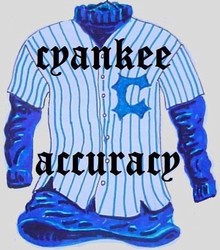Bill Calfee
Gun Fool
Differences and similarities between centerfire MD's and rimfire MD's
CYA friends:
First of all, Happy 4th of July.
______________________________
Now.
The muzzle device for RFBR has pretty much been standardized for the past 20 plus years, or so.
Probably 95%, or more, of RFBR guns are equipped with the HH/MD, and for good reason; it is correctly configured to stop the muzzle of RFBR sized barrels.
The above can not be said for our CFBR friends.
Which is a shame, since stopping the muzzle of a CFBR barrel shouldn't be any more complicated than for a RFBR barrel.
Therefore, is it possible for our CFBR friends to have a standardized MD available to them, just as we do in RFBR?
__________________________
What are the differences and similarities between centerfire MD's and rimfire MD's:
Similarities:
The main similarity between the two, is they're both designed to stop the muzzle of a gun barrel, when fired.
This means both centerfire and rimfire MD's must place the correct amount of weight, at the correct location past the exit of the crown, to be able to stop the muzzle.
Unfortunately, a lot of our CFBR friends, and even an occasional RFBR shooter, feel a MD, in their case "tuner", is used to tune a load to the barrel, or vice versa, during competition.
____________________________
Differences:
Centerfire MD's have to deal with recoil, which defines how they're attached to the muzzle.
(Hence the subject of another thread currently here at CYA)
Also, since centerfire barrels are usually much stiffer than rimfire barrels, the weight requirement of the MD past the exit of the crown is slightly different.
Barrel stiffness determines the location of the exact center of the parallel node of a naked barrel.
The stiffer the barrel, the closer the exact center of the parallel node is to the exit of the crown.
Therefore, most CFBR barrels do not need as much weight ahead of the exit of the crown, as do RFBR barrels.
_____________________
CYA friends, my gut tells me there's an excellent opportunity for a MD maker, like Harrell's for instance, to provide a proper MD for CFBR shooters that will allow them to stop their muzzles just as we do in RFBR.
So here's what I believe could make some MD maker own the market for CFBR MD's, just like Harrell's does today in RFBR.
They must provide a MD that does not require the muzzle of the barrel to be threaded.
While at the same time providing a CFBR MD that places the correct weight at the correct location past the exit of the crown, to stop the muzzle.
Your friend, Bill Calfee
CYA friends:
First of all, Happy 4th of July.
______________________________
Now.
The muzzle device for RFBR has pretty much been standardized for the past 20 plus years, or so.
Probably 95%, or more, of RFBR guns are equipped with the HH/MD, and for good reason; it is correctly configured to stop the muzzle of RFBR sized barrels.
The above can not be said for our CFBR friends.
Which is a shame, since stopping the muzzle of a CFBR barrel shouldn't be any more complicated than for a RFBR barrel.
Therefore, is it possible for our CFBR friends to have a standardized MD available to them, just as we do in RFBR?
__________________________
What are the differences and similarities between centerfire MD's and rimfire MD's:
Similarities:
The main similarity between the two, is they're both designed to stop the muzzle of a gun barrel, when fired.
This means both centerfire and rimfire MD's must place the correct amount of weight, at the correct location past the exit of the crown, to be able to stop the muzzle.
Unfortunately, a lot of our CFBR friends, and even an occasional RFBR shooter, feel a MD, in their case "tuner", is used to tune a load to the barrel, or vice versa, during competition.
____________________________
Differences:
Centerfire MD's have to deal with recoil, which defines how they're attached to the muzzle.
(Hence the subject of another thread currently here at CYA)
Also, since centerfire barrels are usually much stiffer than rimfire barrels, the weight requirement of the MD past the exit of the crown is slightly different.
Barrel stiffness determines the location of the exact center of the parallel node of a naked barrel.
The stiffer the barrel, the closer the exact center of the parallel node is to the exit of the crown.
Therefore, most CFBR barrels do not need as much weight ahead of the exit of the crown, as do RFBR barrels.
_____________________
CYA friends, my gut tells me there's an excellent opportunity for a MD maker, like Harrell's for instance, to provide a proper MD for CFBR shooters that will allow them to stop their muzzles just as we do in RFBR.
So here's what I believe could make some MD maker own the market for CFBR MD's, just like Harrell's does today in RFBR.
They must provide a MD that does not require the muzzle of the barrel to be threaded.
While at the same time providing a CFBR MD that places the correct weight at the correct location past the exit of the crown, to stop the muzzle.
Your friend, Bill Calfee

